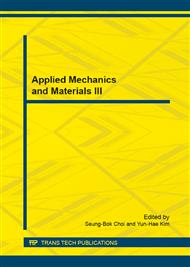[1]
Wu, Y. -F. and Y. -Y. Wei, Effect of cross-sectional aspect ratio on the strength of CFRP-confined rectangular concrete columns. Engineering Structures, 2010. 32(1): pp.32-45.
DOI: 10.1016/j.engstruct.2009.08.012
Google Scholar
[2]
Shekari, A. and M. Razzaghi, Influence of nano particles on durability and mechanical properties of high performance concrete. Procedia Engineering, 2011. 14: pp.3036-3041.
DOI: 10.1016/j.proeng.2011.07.382
Google Scholar
[3]
Arboleda, D., Fabric Reinforced Cementitious Matrix (FRCM) Composites for Infrastructure Strengthening and Rehabilitation: Characterization Methods. (2014).
Google Scholar
[4]
Shetty, M., Concrete Technology (ME)2005: S. Chand.
Google Scholar
[5]
Lepech, M.D. and V.C. Li, Sustainable pavement overlays using engineered cementitious composites. J Pavement Res Technol, 2010. 3(5): pp.241-250.
Google Scholar
[6]
Acker, P. and F. -J. Ulm, Creep and shrinkage of concrete: physical origins and practical measurements. Nuclear Engineering and Design, 2001. 203(2): pp.143-158.
DOI: 10.1016/s0029-5493(00)00304-6
Google Scholar
[7]
Ben Fraj, A., M. Kismi, and P. Mounanga, Valorization of coarse rigid polyurethane foam waste in lightweight aggregate concrete. Construction and Building Materials, 2010. 24(6): pp.1069-1077.
DOI: 10.1016/j.conbuildmat.2009.11.010
Google Scholar
[8]
Hillerborg, A., M. Modéer, and P. -E. Petersson, Analysis of crack formation and crack growth in concrete by means of fracture mechanics and finite elements. Cement and concrete research, 1976. 6(6): pp.773-781.
DOI: 10.1016/0008-8846(76)90007-7
Google Scholar
[9]
Drabik, M., S.C. Mojumdar, and R. Slade, Prospects of novel macro-defect-free cements for the newmillennium. Ceramics-Silikaty, 2002. 46(2): pp.68-73.
Google Scholar
[10]
Tam, C.M., V.W. Tam, and K.M. Ng, Assessing drying shrinkage and water permeability of reactive powder concrete produced in Hong Kong. Construction and Building Materials, 2012. 26(1): pp.79-89.
DOI: 10.1016/j.conbuildmat.2011.05.006
Google Scholar
[11]
Li, V.C., Large volume, high‐performance applications of fibers in civil engineering. Journal of Applied Polymer Science, 2002. 83(3): pp.660-686.
DOI: 10.1002/app.2263
Google Scholar
[12]
Rouse, J.M., et al., Design, construction, and field testing of an ultra-high performance concrete pi-girder bridge, (2011).
Google Scholar
[13]
Kreiger, E.L., Model to describe the mode I fracture of steel fiber reinforced ultra-high performance concrete. (2012).
DOI: 10.37099/mtu.dc.etds/248
Google Scholar
[14]
van Zijl, G.P., Durability under mechanical load–micro-crack formation (ductility), in Durability of Strain-Hardening Fibre-Reinforced Cement-Based Composites (SHCC)2011, Springer. pp.9-39.
DOI: 10.1007/978-94-007-0338-4_2
Google Scholar
[15]
O'Connell, S., Development of a New High Performance Synthetic Fiber for Concrete Reinforcement. (2012).
Google Scholar
[16]
Bartolo, P., et al., Biomedical production of implants by additive electro-chemical and physical processes. CIRP Annals-Manufacturing Technology, 2012. 61(2): pp.635-655.
DOI: 10.1016/j.cirp.2012.05.005
Google Scholar
[17]
Mallick, P.K., Fiber-reinforced composites: materials, manufacturing, and design1993: CRC press.
Google Scholar
[18]
Deng, F. and Z. Hong, Focus on Sustainable Bearing Structures. Applied Mechanics and Materials, 2013. 405: pp.1182-1186.
DOI: 10.4028/www.scientific.net/amm.405-408.1182
Google Scholar
[19]
Neville, A. and P. -C. Aitcin, High performance concrete—an overview. Materials and structures, 1998. 31(2): pp.111-117.
Google Scholar
[20]
Li, M. and V.C. Li, High-early-strength engineered cementitious composites for fast, durable concrete repair—material properties. ACI materials journal, 2011. 108(1).
DOI: 10.14359/51664210
Google Scholar
[21]
Winnefeld, F., et al., Effects of the molecular architecture of comb-shaped superplasticizers on their performance in cementitious systems. Cement and Concrete Composites, 2007. 29(4): pp.251-262.
DOI: 10.1016/j.cemconcomp.2006.12.006
Google Scholar
[22]
Meyer, R.M., et al., Advanced Instrumentation, Information, and Control System Technologies: Nondestructive Examination Technologies-FY11 Report. Pacific Northwest National Laboratory, PNNL-20671, Richland, Washington, (2011).
DOI: 10.2172/1042559
Google Scholar
[23]
Khayat, K.H., J. Assaad, and J. Daczko, Comparison of field-oriented test methods to assess dynamic stability of self-consolidating concrete. ACI Materials Journal, 2004. 101(2).
DOI: 10.14359/13066
Google Scholar
[24]
Hu, J., A study of effects of aggregate on concrete rheology. (2005).
Google Scholar
[25]
Santhanam, M., M.D. Cohen, and J. Olek, Sulfate attack research—whither now? Cement and concrete research, 2001. 31(6): pp.845-851.
DOI: 10.1016/s0008-8846(01)00510-5
Google Scholar
[26]
Kim, H. and H. Melhem, Damage detection of structures by wavelet analysis. Engineering Structures, 2004. 26(3): pp.347-362.
DOI: 10.1016/j.engstruct.2003.10.008
Google Scholar
[27]
Sharma, S., Monitoring of Damage in Reinforcement in Concrete, 2010, THAPAR UNIVERSITY.
Google Scholar
[28]
Alberti, G., et al., Polymeric proton conducting membranes for medium temperature fuel cells (110–160 C). Journal of Membrane Science, 2001. 185(1): pp.73-81.
DOI: 10.1016/s0376-7388(00)00635-9
Google Scholar


